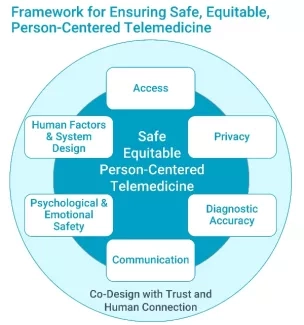Why It Matters
In the rush to move patient care to virtual platforms due to COVID-19, not all telemedicine has prioritized safety, equity, and person-centeredness. The Institute for Healthcare Improvement's Lucian Leape Institute convened a panel in 2020 to address these gaps and look to the future. The result is the Telemedicine: Ensuring Safe, Equitable, Person-Centered Virtual Care white paper. In the following interview, one of the white paper’s co-authors, IHI Senior Director Allison Perry, explains why it would be a mistake to make too many assumptions about telemedicine.
How do you define the difference between telemedicine and telehealth?
That’s a great question because these terms are often used interchangeably in both the field and in the literature. Telehealth is defined as the delivery of health-related services and information via telecommunications technologies. It’s a broad category that encompasses patient care, administrative activities, and health education.
Telemedicine is a more specific term referring to diagnosis and treatment of patients through telecommunications technologies. IHI’s Telemedicine: Ensuring Safe, Equitable, Person-Centered Virtual Care white paper primarily focuses on telemedicine although implications for telehealth, more generally, are also considered.
Why was IHI’s white paper on telemedicine developed?
IHI had begun early investigations into telemedicine prior to the COVID-19 pandemic. We found that while health systems around the world have been making significant investments in telemedicine, little attention has been paid to broader safety concerns and the potential unintended consequences of virtually provided care. And then, of course, the COVID pandemic greatly accelerated a shift towards telemedicine and the diagnosis and treatment of patients through telecommunications technology. This shift, coupled with IHI’s initial research, prompted us to dive deeper into the quality of telehealth.
In June 2020, the IHI Lucian Leape Institute convened a panel of experts from around the globe to talk about how we might develop quality telehealth care. We wanted to take a close look at both the risks and opportunities in delivering telemedicine. We were still in the early stages of the pandemic, so there was a sense of urgency when we first convened because so many [practitioners] around the world were making this rapid conversion, with very little understanding around potential risks, and many [health care providers and patients] had no telehealth experience. Suddenly, we were faced with these huge challenges, and there was very little knowledge available about designing for and delivering quality telemedicine. Now that the initial crisis is behind us, and we anticipate that telemedicine is here to stay, it’s important not to just design for crisis, but to design for the future of health care.
What does it mean to use technology to provide high-quality telemedicine versus provide care as usual on video or on the phone?
One of the things we talk about in the white paper is the need to redesign the way that care is delivered and not just put the technology on top of an existing process. It’s not just about delivering the care in a way we think it should be delivered. What’s most important is taking the time to understand the needs of the patients and the community of patients we serve. This means doing more than looking at all the patients in a community and delivering care for one type of patient. It means addressing the needs and preferences of the individual patient and understanding how to use telehealth to address inequities.
How would you summarize the white paper?
The culmination of our IHI Lucian Leape Institute expert panel discussion is a framework (see Figure 1) that includes six elements that emerged from the expert panel discussion — access, privacy, diagnostic accuracy, communication, psychological and emotional safety, and human factors and system design — to ensure safe, equitable, person-centered telemedicine. The paper examines the risks that may arise and explores specific actions organizations can take to manage the identified risks and provide high-quality virtual care.

Figure 1. Framework for Ensuring Safe, Equitable, Person-Centered Telemedicine
The white paper also highlights the importance of co-designing telemedicine services with key stakeholders, including patients, families, and the health care workforce and reflects on the future of telemedicine.
How should readers take full advantage of the white paper?
We encourage organizations to explore the six elements of the framework. Familiarize yourself with the recommendations that accompany each element. In doing so, it will be important for you to consider your organization’s unique context. What is your existing technological infrastructure? What resources do you and those in your community have? And we recommend using the Model for Improvement and Plan Do Study Act (PDSA) cycles to support testing, implementation, establishing measures, and scaling up the delivery of quality telemedicine.
Organizations should consider using this white paper as a compass to point them toward safe, equitable, and patient-centered care. Consider carefully what equity and inequity mean in the context of telemedicine. How can we avoid creating a system that increases inequities? Consider the overall patient experience and whether we are meeting patients’ health care needs at every encounter. Pay attention to the preferences of individual patients. Consider the unique patient safety risks and opportunities of your context when providing care virtually.
Finally, this paper not only highlights the risks associated with telemedicine, but also certain advantages that can be leveraged to support improved care delivery. Ultimately, this moment is not just an opportunity to design quality telemedicine, but a chance to redesign health care delivery.
Editor’s note: This interview has been edited for length and clarity.
You may also be interested in:
IHI white paper: Telemedicine: Ensuring Safe, Equitable, Person-Centered Virtual Care
Tips You May Not Know to Improve Telehealth for Patients and Providers
